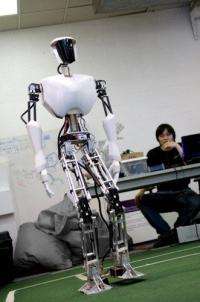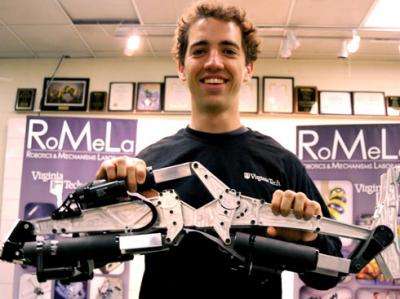Virginia Tech students build CHARLI, a full-sized humanoid robot (w/ Video)

(PhysOrg.com) -- As CHARLI takes his first steps, anxious onlookers stand ready to catch him if he falls. His stride is short, but upright, as one foot is placed in front of the other in the basement of Virginia Tech’s Randolph Hall.
But CHARLI is no toddler.
He is a 5-foot tall humanoid robot built by graduate and undergraduate students with the Virginia Tech College of Engineering’s Robotics and Mechanisms Laboratory (RoMeLa).
After a long moment, CHARLI comes to a rest. An audible “Whew!” is heard from CHARLI’s main architect, doctoral student Jeakweon (“J.K.”) Han. Dennis Hong, associate professor of mechanical engineering and director of RoMeLa, can’t resist a joke.
“One small step for a robot, one giant leap for robotics,” he shouted.
Hong isn’t entirely facetious, though. CHARLI (that’s for Cognitive Humanoid Autonomous Robot with Learning Intelligence) is historic. CHARLI is the first untethered, autonomous, full-sized, walking, humanoid robot with four moving limbs and a head, built in the United States. His two long legs and arms can move and gesture thanks to a combination of pulleys, springs, carbon fiber rods, and actuators. CHARLI soon will be able to talk as well.
Fans of robotics are taking note.
“This is a significant milestone in robotics engineering and is a testament to the technological leadership of Virginia Tech’s RoMeLa lab,” said Tom Atwood, editor of “Robot” magazine.
Of course it will be many years before CHARLI or his incarnations will be seen walking around campus or even in homes across America. Hong refers to the latter placement as his “Jetsons Goal” (named for the popular 1960s cartoon that featured Rosie, a robotic maid for the futuristic family).
“The environment we live in is designed for humans: The step size of stairs, the height of door handles, etc., are designed by humans for humans,” Hong said. “Thus for a robot to live among us and to serve us, it needs human size and form. Thus humanoids. But, manipulation with hands, perception, intelligence, and autonomy are all important and difficult research problems that need to be addressed.”
That research is under way. There are two CHARLIs.

The one now walking across floors and motioning his arms is CHARLI L, as in Lightweight. He’s meant to walk indoors on known flat surfaces, but not run or jump. Eventually, he will be able to kick soccer balls. The robot is expected to debut at this year’s RoboCup tournament in Singapore.
Then there is CHARLI H (for Heavy). This bulkier robot will utilize custom-designed actuators and other technologies that one day will allow it walk on the sloping, rising ground that comprises Virginia Tech’s campus. He also will be able to run, jump, kick, open doors, pick up objects, and do just about anything a real person can do.
“CHARLI H will be a fully functioning robot,” said Derek Lahr, a Ph.D. student from Charleston, S.C., who is spearheading the “H” project. For now, only one leg of CHARLI H is complete.
The students built CHARLI L with $20,000 in seed money from the Virginia Tech Student Engineers’ Council and donated equipment from National Instruments and Maxon Precision Motors. “The budget constraints actually inspired us to think of different solutions, ‘How can we actually make this happen with a small budget?' And that actually led us to new types of mechanical solutions,” Hong said.
Work on the robot began in 2008 with 13 undergraduate and graduate students working on the project at any given time. Inspiration came from science-fiction films and spouses.
“I hope CHARLI could help physically challenged people to cook, clean, and carry items like the NS-5,” said Han, referring to the humanoid robot at the center of the 2004 film “I, Robot.” Han’s design concept was assisted by his wife, Younseal Eum, who is an artist.
Atwood said he is excited for the future. “Eventually, there will be a robot in every home assisting families and individuals, and walking robots will find work in all kinds of places, from warehouses to manufacturing centers,” he said.
Indeed, Hong will have seen his “Jetsons Goal” come true.
Provided by Virginia Tech


















